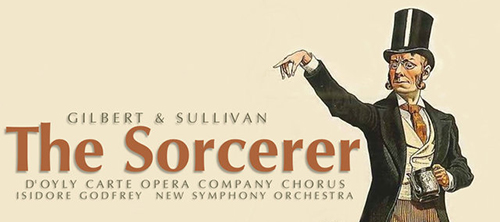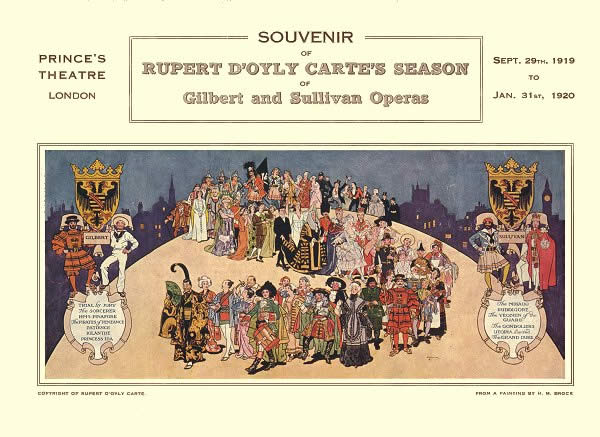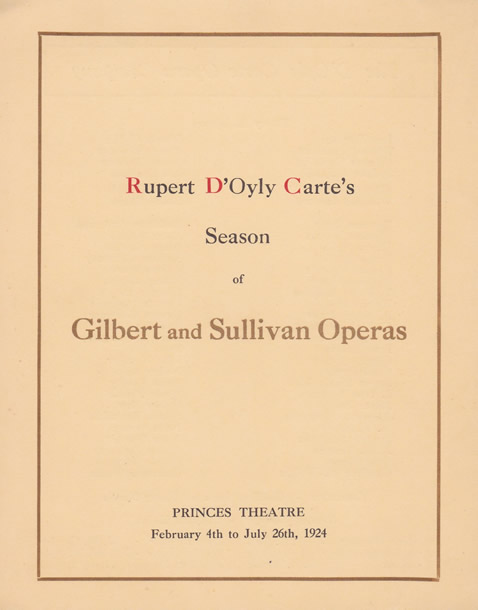Sorcerer (The)
Musical (1877)

Après le succès précoce et retentissant de leur opéra en un acte "Trial By Jury" en 1875, Gilbert et Sullivan, et leur producteur Richard D'Oyly Carte, décidèrent de produire une œuvre plus longue. Gilbert a retravaillé et allongé un de ses écrits antérieurs (An Elixir of Love) basé sur un thème d'opéra pour créer une intrigue autour d'un philtre d'amour magique qui ferait tomber tout le monde amoureux, mais du mauvais partenaire.
"The Sorcerer" a été créé à l'Opéra Comique de Londres, un charmant petit théâtre du Strand, le 17 novembre 1877. La série originale de la pièce a duré 175 représentations, un succès suffisant pour encourager Gilbert & Sullivan à continuer à collaborer, ce qui a conduit à leur pièce suivante, le HMS Pinafore.
In 1871, W. S. Gilbert and Arthur Sullivan had written Thespis, an extravaganza for the Gaiety Theatre's holiday season that did not lead immediately to any further collaboration. Three years later, in 1875, talent agent and producer Richard D'Oyly Carte was managing the Royalty Theatre, and he needed a short opera to be played as an afterpiece to Jacques Offenbach's La Périchole. Carte was able to bring Gilbert and Sullivan together again to write the one-act piece, called Trial by Jury, which became a surprise hit. The piece was witty, tuneful and very "English", in contrast to the bawdy burlesques and adaptations of French operettas that dominated the London musical stage at that time. Trial by Jury proved even more popular than La Périchole,[6] becoming an unexpected hit, touring extensively and enjoying revivals and a world tour.
After the success of Trial by Jury, several producers attempted to reunite Gilbert and Sullivan, but difficulties arose. Plans for a collaboration for Carl Rosa in 1875 fell through because Gilbert was too busy with other projects, and an attempted Christmas 1875 revival of Thespis by Richard D'Oyly Carte failed when the financiers backed out. Gilbert and Sullivan continued their separate careers, though both continued writing light opera. Finally, in 1877, Carte organised a syndicate of four financiers and formed the Comedy Opera Company, capable of producing a full-length work. By July 1877, Gilbert and Sullivan were under contract to produce a two-act opera. Gilbert expanded on his own short story that he had written the previous year for The Graphic, "An Elixir of Love," creating a plot about a magic love potion that – as often occurs in opera – causes everyone to fall in love with the wrong partner.
Now backed by a company dedicated to their work, Gilbert, Sullivan and Carte were able to select their own cast, instead of using the players under contract to the theatre where the work was produced, as had been the case with their earlier works. They chose talented actors, most of whom were not well-known stars; and so did not command high fees, and whom they felt they could mould to their own style. Then, they tailored their work to the particular abilities of these performers. Carte approached Mrs Howard Paul to play the role of Lady Sangazure in the new opera. Mr and Mrs Howard Paul had operated a small touring company booked by Carte's agency for many years, but the couple had recently separated. She conditioned her acceptance of the part on the casting of her 24-year-old protege, Rutland Barrington. When Barrington auditioned before W. S. Gilbert, the young actor questioned his own suitability for comic opera, but Gilbert, who required that his actors play their sometimes-absurd lines in all earnestness, explained the casting choice: "He's a staid, solid swine, and that's what I want." Barrington was given the role of Dr Daly, the vicar, which was his first starring role on the London stage.
For the character role of Mrs. Partlet, they chose Harriett Everard, an actress who had worked with Gilbert before. Carte's agency supplied additional singers, including Alice May (Aline), Giulia Warwick (Constance), and Richard Temple (Sir Marmaduke). Finally, in early November 1877, the last role, that of the title character, John Wellington Wells, was filled by comedian George Grossmith. Grossmith had appeared in charity performances of Trial by Jury, where both Sullivan and Gilbert had seen him (indeed, Gilbert had directed one such performance, in which Grossmith played the judge), and Gilbert had earlier commented favourably on his performance in Tom Robertson's Society at the Gallery of Illustration. After singing for Sullivan, upon meeting Gilbert, Grossmith wondered aloud if the role shouldn't be played by "a fine man with a fine voice". Gilbert replied, "No, that is just what we don't want."
The Sorcerer was not the only piece on which either Gilbert or Sullivan were working at that time. Gilbert was completing Engaged, a "farcical comedy", which opened on 3 October 1877. He also was sorting out the problems with The Ne'er-do-Weel, a piece he wrote for Edward Sothern. Meanwhile, Sullivan was writing the incidental music to Henry VIII; only after its premiere on 28 August did he begin working on The Sorcerer. The opening was originally scheduled for 1 November 1877; however, the first rehearsals took place on 27 October, and the part of J. W. Wells was filled only by that time. The Sorcerer finally opened at Opera Comique on 17 November 1877.
Le riche mais peu intelligent Alexis a une vision: la joie du mariage fera disparaître tout malheur terrestre. Appliquant à lui-même ce qu’il a prêché, Alexis s'est récemment fiancé à la belle Aline. Mais lors de sa cérémonie de mariage, il veut généraliser à tous sa conviction: apporter la joie du mariage à toute la ville. Pour y parvenir, il invite le patron de J.W. Wells & Co., Family Sorcerers, à préparer un philtre d'amour. Cela a un effet immédiat: tout le monde dans le village tombe amoureux de la première personne qu'il voit. Mais cela aboutit à créer des couples comiquement dépareillés. En fin de compte, Wells doit sacrifier sa vie pour briser le charme.
Afficher le synopsis détaillé
Chorus of Villagers
Acte I
It is mid-day and the villagers of Ploverleigh are assembled in front of the Elizabethan Mansion of Sir Marmaduke Pointdextre, voicing their joy at the betrothal of Sir Marmaduke's heir Alexis to Aline, the only child of an equally aristocratic neighbour, the Lady Sangazure. There is one present, however, who does not share in the general joy. Constance, the daughter of Mrs. Partlet, is downcast and confesses to her mother that she loves (vainly, it seems) the Vicar, Dr. Daly. On his appearance they withdraw and Dr. Daly sings the notable ballad, "Time was when Love and I were well acquainted," in which he laments the days now gone when, as a pale young curate, he had the adoration of the maidens of his flock. Mrs. Partlet, anxious to help Constance, comes forward and leads the conversation to the subject of marriage, but it is obvious from his replies that he looks on himself as a confirmed bachelor, and Constance is led away sobbing by her mother.
The Vicar now turns to welcome Sir Marmaduke and Alexis in weighty language, and with a touch of allegory that pleases Sir Marmaduke, who is a great admirer of the school of stately compliment, and a stickler for "blue blood." He claims that his own family is directly descended from Helen of Troy, and is all for a marriage of pedigree, regarding love as a comparatively unimportant accessory.
Aline makes her appearance and is greeted by the village girls. She acknowledges their good wishes, and her mother, Lady Sangazure, adds her congratulations. The men now welcome Alexis and the lovers greet each other with ecstasy. Then follows a stately duet ("Welcome joy, adieu to sadness") between Sir Marmaduke and Lady Sangazure, who were lovers in their young days. The stately gavotte measure is punctuated by their dreams of what might have been.
A notary has now arrived, all is prepared for signing the marriage contract. This done, Alexis and Aline are left together. Alexis does not agree with the views of his father, and, believing that men and women should be coupled in matrimony without distinction of rank, has done some propaganda on the subject. So far, however, his ideas have only been welcomed by the humbler classes. His own happiness seeming assured, he reveals his scheme for making the whole village happy. He has engaged John Wellington Wells, a Sorcerer, to administer secretly a love-philtre to all the others, which will first send them to sleep, and on their awaking cause them to fall madly in love with the first person of the opposite sex they may see who has also drunk the potion. It has no effect on those already married.
Mr. Wells is introduced in the well-known patter song, and then details are discussed. It is decided that the philtre shall be placed in a large teapot which will be used for the "banquet" to follow. Mr. Wells then proceeds to his horrific Incantation, and after the Fiends have disappeared, the villagers return, make merry, and each drinks of the enchanted tea. The act closes as, after struggling vainly against the charm, all present save Alexis, Aline and the Sorcerer fall insensible.
Acte II
It is midnight, and the villagers are still lying where they have fallen. Mr. Wells, with a great sense of fitness, has had the more exalted members taken home and put to bed "respectably." As the villagers wake, each falls in love with the first person of the opposite sex visible, Constance and the Notary making one couple.
Alexis is so pleased with his success that he urges Aline to join with him in drinking the philtre, in order that nothing may be left to chance. She refuses, and they quarrel. The remaining characters begin to arrive: first Dr. Daly, the worthy Vicar, who is puzzled because, in a village hitherto rather slow in the matter of marriage, he has suddenly had a request for hasty weddings from everyone -- even Sir Marmaduke. Alexis is none too pleased when he finds that the philtre has led the Baronet to fix on Mrs. Partlet, the Pew Opener. Still, he must live up to his opinions, and there is a congratulatory quintet from those concerned.
Mr. Wells, having caused the mischief, falls a victim to his own spell, for Lady Sangazure, entering, sees him and at once adores him. He, on the other hand, not having drunk the philtre, does not reciprocate, and in an amusing duet endeavours to dissuade her. Without success, however, for she threatens to bury her woe in her family vault.
Aline, having pondered the matter, has decided to fall in with her lover's wish, and drinks the philtre. Immediately afterwards, she catches sight of Dr. Daly and of course falls in love with him. He is delighted at his good fortune, but Alexis, coming in full of remorse, is astounded to find his embraces repulsed. Explanations ensue, and the Vicar obligingly offers to quit the country and bury his sorrow "in the congenial gloom of a Colonial Bishopric."
This is not enough, for Aline is still under the influence of the philtre, and no longer loves Alexis. They appeal to Mr. Wells, who reveals that there is one way only in which the spell can be revoked. Either he or Alexis must sacrifice himself to Ahrimanes. Argument ensues, and the issue is put to popular vote; John Wellington Wells loses and disappears into the earth to the sound of a gong.
All quit their temporary partners to rejoin their old lovers, and Sir Marmaduke, claiming Lady Sangazure, invites them all to another feast in his mansion.
Sir Marmaduke Pointdextre, an Elderly Baronet (bass-baritone)
Alexis, of the Grenadier Guards, his son (tenor)
Dr Daly, Vicar of Ploverleigh (lyric baritone)
Notary (bass)
John Wellington Wells, of J. W. Wells & Co., Family Sorcerers (comic baritone)
Lady Sangazure, a Lady of Ancient Lineage (contralto)
Aline, her Daughter, betrothed to Alexis (soprano)
Mrs. Partlet, a Pew Opener (contralto)
Constance, her Daughter (soprano (1877); mezzo-soprano or soprano (1884))
Hercules (speaking role)
Chorus of villagers
Aucun dossier informatif complémentaire concernant Sorcerer (The)
Aucun dossier informatif complémentaire concernant Sorcerer (The)

Version 1
Sorcerer (The) (1919-09-Prince's Theatre-London) G&S Season
Type de série: RevivalThéâtre: Shaftesbury Theatre (Londres - Angleterre) Durée : 4 mois Nombre : Première Preview : 29 September 1919
Première: 29 September 1919
Dernière: 31 January 1920Mise en scène : Chorégraphie : Producteur : D'Oyly Carte Opera Company • Star(s) : Presse : "L'admirable compagnie se distingue par l'inclusion d'un nouveau ténor, M. Derek Oldham, dont la présence et les manières agréables, les capacités d'acteur et la voix exquise ravissent autant que celles de n'importe quel Marco que j'ai vu et entendu. Le duc de M. Henry Lytton, le Don Alhambra de M. Leo Sheffield et la duchesse de Miss Bertha Lewis sont tous en accord avec les traditions du pays, tandis que Miss Elsie Griffin et Miss Nellie Briercliffe formaient un couple d'épouses satisfaisant. L'enthousiasme du public était sans limite." - London Sunday Times
"Après quatre années de guerre et les misères qui en découlent, que se soucie le public britannique d'un inconvénient aussi insignifiant qu'une simple grève des chemins de fer ? Certainement pas assez pour se permettre d'être tenu à l'écart d'un événement aussi primordial que la reprise de Gilbert et Sullivan au Prince's Theatre, où un public immense était venu accueillir l'excellente compagnie de M. D'Oyly Carte lors de sa première visite au centre de Londres. C'était un public brillant et il comprenait non seulement de nombreuses personnalités sociales, théâtrales et musicales de l'époque, mais aussi un certain nombre de ces vieux Savoyards aux noms desquels les opéras de Gilbert et de Sullivan doivent toujours être irrévocablement associés. Miss Jessie Bond, Miss Geraldine Ulmar et M. Rutland Barrington étaient tous là." - Daily Telegraph

Version 2
Sorcerer (The) (1924-02-Prince's Theatre-London) G&S Season
Type de série: RevivalThéâtre: Shaftesbury Theatre (Londres - Angleterre) Durée : 5 mois 3 semaines Nombre : Première Preview : 04 February 1924
Première: 04 February 1924
Dernière: 26 July 1924Mise en scène : Chorégraphie : Producteur : D'Oyly Carte Opera Company • Star(s) :
Pas encore de video disponible pour ce spectacle